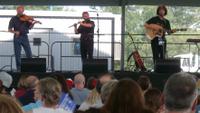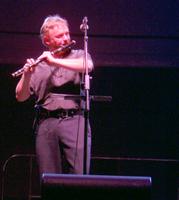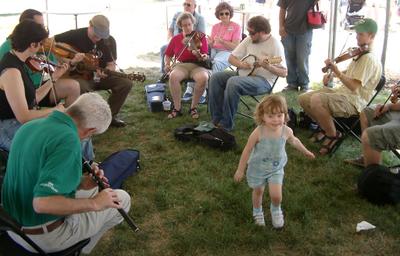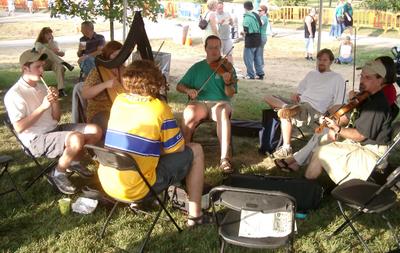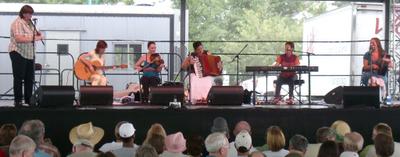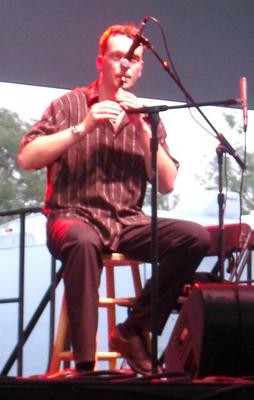 Colin Melville has played Highland pipes, Scottish smallpipes, and whistles for the Tannahill Weavers for five years. I spoke to Colin after their Saturday evening show at the 2005 Dublin Irish Festival.
Colin Melville has played Highland pipes, Scottish smallpipes, and whistles for the Tannahill Weavers for five years. I spoke to Colin after their Saturday evening show at the 2005 Dublin Irish Festival.
The tape of the interview is quite noisy, so any errors in transcription are of course mine.
Learning to Whistle: Do you think there's any such thing as a "Scottish whistling style" (as opposed to repertoire), or is whistling pretty much wistling?
Colin Melville: I think the actual method of playing is pretty much the same for everybody. I think when you talk about Irish style or Scottish style or whatever else it's more with the material you're playing, and playing style is probably more down to the individual than the country you're from, I guess.
LTW: It does seem to be fairly common that a lot of Scottish whistlers are also pipers. How does piping affect your whistling?
CM: Well, obviously you use your fingers, so that's similar, but you know the scale is completely different. Obviously, with the bagpipes you've only got nine notes to deal with (obviously have a lot more on the whistle) and you have to learn a lot of new decorations. That's probably the toughest part, for a piper to change their decorations. When you first pick [the whistle] up you try and do the same things, but you have to start using tonguing and stuff like that. It's a different discipline.
LTW: How do you rehearse a tune where you use pipes and whistle at the same time? ...There's such a difference in volume...
CM: When we practice with the band — well, most practices — I usually use the [Scottish] smallpipes, in place of the Highland pipes just for that reason, in spite of the fact that it makes for a color difference acoustically. Other people can hear what they're practicing as well!
LTW: I've read that when you play the whistle and the Highland pipes together you use an E♭ whistle, but it looked like Phil was playing an A whistle tonight?
CM: No, everything we use in the band is all — well, because of the pipes being in B♭ — is tuned around that. There are capos on the guitar and the bouzouki, and the fiddle is tuned up. All the whistles and flutes are E♭ or B♭. The one which looked like A, that'd be a B♭, and then you've got the high E♭ and the low E♭s.
LTW: Right, because [the Highland pipes, which play a tone closer to B♭ when an A is fingered] are not concert pitch....
CM: Yeah.
LTW: In terms of playing the whistle, who are your favorite artists to listen to for performance ideas?
CM: I'd have to say Brian Finnegan. He's a star. I can't get my head around some of the stuff he does with it sometimes. With Flook, his band; they're great. You know, there's so many up-and-coming guys that play, a lot of them pipers... they're getting into different instruments. Findlay Napier (of Back of the Moon), I heard him recently playing the flute... absolutely fantastic. Finlay MacDonald, a great piper, he's also really good on the whistle especially.
LTW: Let's say you like to listen to Scottish music and you want to learn to play it; is there a "short list" of "core tunes" you might want to start with...? I'm not saying you need to list the tunes, but where would you look to begin with?
CM: It's kind of funny, when you go around Scotland, to different parts of the country, if you go down to sessions or if you play with local musicians, you do find that small regions have a set, "core tunes," but when you go to different regions there are different "core tunes." There are obviously some that transcend, but everybody has a set of tunes that they can easily play together. But it's funny, when you go to a different side of the country it's a different set of tunes. And that's the way that you find them. Most people, to find them, go to sessions, play with other guys, and you hear them all the time. I wouldn't say there are specific books or recordings that have got just these tunes in them....
LTW: ...because I look at the Tannahill Weavers and there are a lot of tunes which interest me, but you guys have [14] CDs, and...
CM: Yeah, where do you start? Funny enough, a lot of tunes that the Tannahills recorded way, way back, they're now very popular tunes, whereas when they recorded them they were unheard of.
LTW: I was trying to learn Tranent Muir by ear from your recording and play it on the whistle and I kept needing to go into the third octave....
CM: Very often you just make something up which sounds OK. The songs do tend to go way out, further than a whistle can, definately further than the pipes can. So you very often find yourself trying to stick as much as you can to the melody line but when it goes way above or below you just have to make something up!
LTW: You do [onstage] some fairly impressive feats of instrument changes [e.g., going from the whistle to the smallpipes to the Highland pipes, which requires strapping and unstrapping the smallpipe bellows]....
CM: [Laughs.] Not for the first time I've been caught out a few times — everyone's staring at me, and I'm... "What's wrong?" I'm supposed to be playing the smallpipes or something and I'm just standing there.
LTW: I know you guys recorded a tune from a Scottish whistle tutor. But I haven't seen that book in the U.S. Have you ever seen a whistle tutorial with Scottish music that you liked?
CM: To be honest, I kind of learned through sessions, and bands playing along. When I started playing folk music I was a piper, and I thought, I've only got a few sets [for the pipes]; I'd be sitting there the rest of the night, and I thought, I'm going to have to do something here. So that's how I started playing the whistle. Kind of unconventional roots. I have come across a few tutorial books over the years and they're varied in quality. You know, everyone has at least something that teaches you something new, so it may just be best to go out and buy a few of them, if you can find a few kind of cheap ones, then you pick up lots of little bits and pieces....
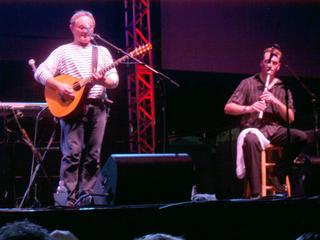 LTW: Can you tell me about the whistles you play; who makes them and what do you like about them?
LTW: Can you tell me about the whistles you play; who makes them and what do you like about them?
CM: The low whistle I play is a Chieftan. I've been playing a low D Chieftan for a long, long time, and when I joined the band I just naturally got an E♭, because I'm just so comfortable with it. I recently ordered a set of high whistles from a guy called Chris Abell, from North Carolina. So you get the same head with the E♭, the D, and C bodies, and I just think they're wonderful. I just got them a couple months ago, and you can really hear them coming in now; they're starting to get "played in." They're just a joy to play. I definately recommend them. We also use the cheap ones; the B♭ one we use is just the Generation. You have to go through a box of them; you have to find a "good one," to spend time going through them.
LTW: How do you orchestrate a tune, decide which instruments you're going to put to it? Is it trial and error or...?
CM: Trial and error to a certain extent. There's a format we use very often on stage. You know, you're not going to put the bagpipes in at the start and play the small whistle at the end because of the power of the bagpipes. You should put them at the end if you're going to put them in a song; you get that blast. As far as choosing my instruments, trying to decide whether to play the whistle with the smallpipes, or the high whistle with the smallpipes, that part usually depends on what Phil is doing, if he's playing the flute and whistle as well. Two whistles together sound lovely; you can throw lovely harmonies in. But if I'm playing smallpipes and he's playing whistle it gives you more freedoms; you can mess up and get away with it! With the same instrument you notice every little — if somebody does something slightly different you can hear it. When playing different instruments it gives you a little bit more of a free reign with what you're doing. So that's something to barter.
LTW: What's it like to join a band that has three decades of history behind it before you came on?
CM: Yeah, it's pretty weird. It's pretty weird. It's great, you know. I was just handed this opportunity... Do you want to join the Tannahill Weavers? "Hmmm... Let me think about that..." [Laughs] Well now I've put in five years and I'm quite comfortable with it. At the start it was quite, quite daunting.
LTW: Did you have to study all their old material, to pick up the tunes?
CM: Yeah, yeah. I knew the piper who was before me in the band; he was very helpful with it. It made things a lot easier because he spent a lot of time going through the material with me. In the first gig — actually, I just remembered that — the first gig I did with them was in Germany, and I only met Roy the afternoon of that gig; it was the first time I'd met him. [Ed. note: Roy lives in the Netherlands.] Up until then we'd just been practicing to tapes and things. That was pretty weird. I was pretty nervous about it, but it all went well I think. I'm still with them so I must be doing something OK.
LTW: It seems like you're doing quite a lot. You're not just piping; you're involved in the production and [writing] the music....
CM: Yeah; that's a really good opportunity for me because the band records — well, we usually do it on our own — so we do a lot of the recording and then there's a sound engineer who comes in and helps us with it. Because if you're in a commercial studio you're really pushed for time; it's all money, money, money. But because we have our own little place we can sit and take our time, follow our ideas and mess about with things.
LTW: Roy told me that you guys never perform The Great Ships live, and I'm curious: Are there songs that just can't be done live, or...?
CM: Yeah, there are some songs that are more difficult to come up with a live arrangement. Just for an example there are a lot of songs and tunes that John plays cello and viola — all sorts of "stringy things!" — and he can't do that live and some things that there'll be a kind of technical part in the arrangment and that becomes a lot more difficult. You have to come up with a new arrangement basically to do that live. We like to do things live pretty much the way they are on the CD.
LTW: Do you have any good stories from your tour?
CM: [Laughs] Uhhh.....
LTW: ...any you're willing to repeat?
CM: Yeah, exactly! Here's a funny one: Coming through customs, coming into the country, just last weekend. John the fiddler, he came up to the guy; you know, you get a little interview. The guy says, "What are you doing here?"
"I play in a band."
[The customs inspector asked] what kind of band, what kind of music do you play, what instrument, and all that, and they're chattin' away, and [the inspector] is writing on this form, and he looked at John, and said, "So, your occupation would be...?"
John said, "Musician."
[The inspector] went to write it and he looked up at John and said, "Umm... I'll just write fiddle player; it's easier to spell."
It's true! Incredible, but true.
That will get me in trouble; I'll get pulled aside on my way out of the country!





